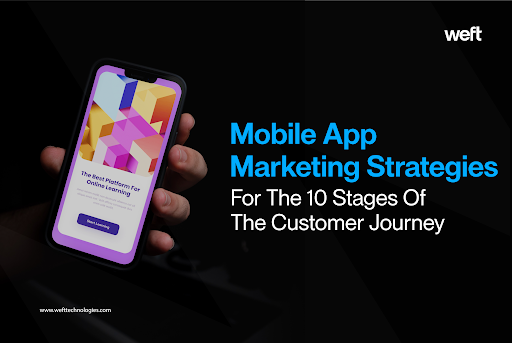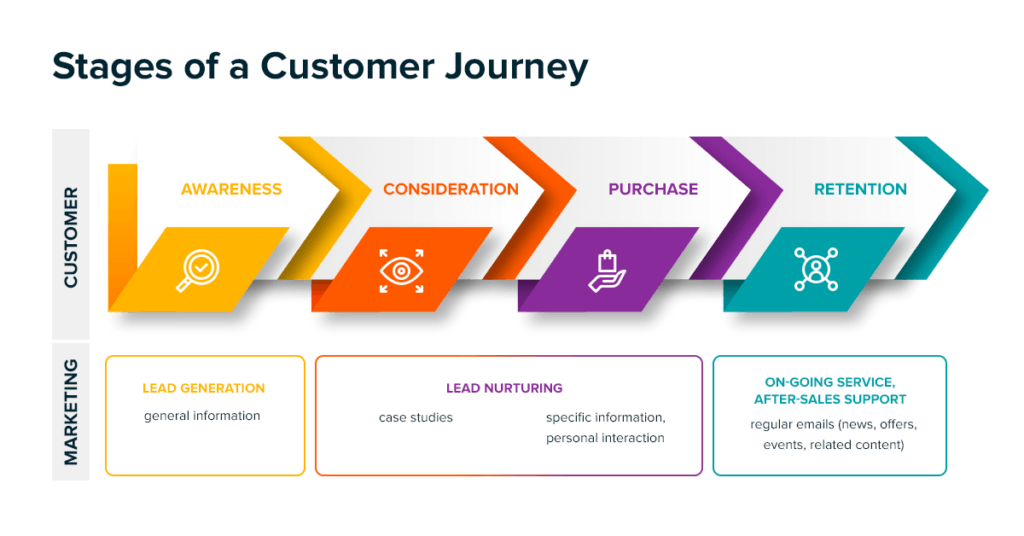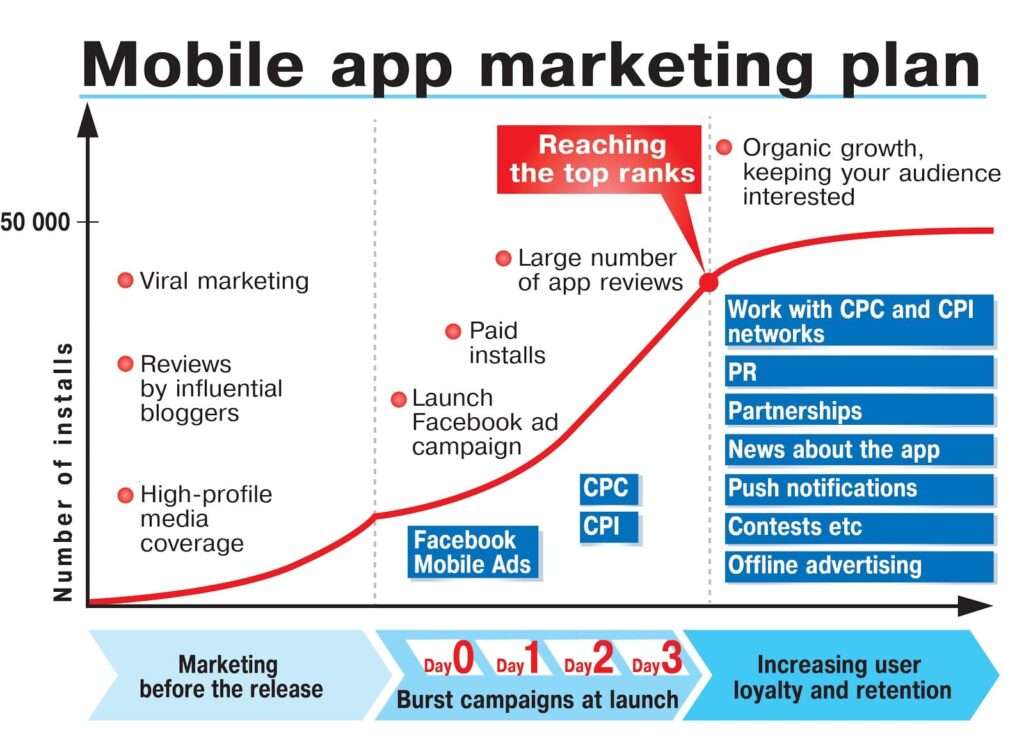
Mobile App Marketing Strategies For The 10 Stages Of The Customer Journey
- Lekshmi SP
- August 8, 2024
Marketing is an extremely general term. You must have heard of social media marketing, website marketing, mobile app marketing, and many more. What you need to understand is that there are so many types of marketing and each type consists of strategies and channels that are more or less unique. Among these, mobile app marketing is a type of marketing that requires extensive research, greater expertise, and consistent work. Wondering why? That is exactly what we will cover in this blog. We are going to take apart the whole process of mobile app marketing. We will cover the different stages of the customer journey and discuss various marketing strategies tailored for each stage.
Understanding Mobile App Marketing
| Simple Definition – The process of marketing or promoting a mobile app. Primary Aim – To increase the number of downloads. |
The above is the simplest explanation for mobile app marketing. But mobile app marketing entails more than just getting some downloads. Once downloaded, the app has to be regularly used by the customer and they have to find it good enough to be referred to someone else. But let’s slow down and take things one at a time. Mobile marketing begins even before the launch of your app. It starts with extensive research, understanding the target audience, and mapping out the customer journey. The buyer journey is then used to prepare a marketing strategy. This strategy will include specific strategies tailored to each stage of the customer journey.
But wait what is this customer journey? Let me explain. Customer journey is the path that customers follow as they interact with your product or service. Sometimes called CX or customer experience, the customer journey is divided into different stages. These stages start from pre-purchase and move through to post-purchase. The various stages of the customer journey are
This rough customer journey map is very important because your marketing strategies must align with the specific needs of your customers at each stage. On another note, utilizing professional mobile app development services can enhance this alignment.
Here’s a breakdown of the key stages in the customer journey and how to tailor your mobile app marketing strategies accordingly:
1. Awareness
A potential customer starts off being unaware of your app. So how do they become aware of your app? We will first try to understand that.
Consider that you are launching a fitness app. Potential customers start their journey when they first search for an app that can guide them on their fitness journey. As they come across all the fitness apps available out there, they might eventually come across your app too. This is how they become aware of your app and this stage is known as the awareness stage.
There are other ways for your customers to become aware of your app. This might be through another person who is already using your app or through a social media ad or post.
You might have already realized that at this stage the main goal for you is to make as many people as possible aware of your app. Think about it. You may have launched the best possible app but what if no one knows about it?
Marketing Strategy: The customers in this stage may already be looking for something similar to what you offer. Reach these customers through content marketing. Create informative articles, blogs, videos, and social media content. Your aim should be to establish yourself as being an authority in your respective industry. Remember that content marketing can only be effective if combined with SEO (Search Engine Optimization). You can also use social media advertising and influencer marketing to widen your reach and target relevant customers.

2. Exploration
The exploration stage is when potential users are exploring different apps to see which one best fits their needs. They might go through screenshots and videos of the apps or try out trial versions.
Marketing Strategy: The marketing strategy to target users at this stage should aim to create a positive first impression. You can do this by following these tips:
- Create a detailed app description that highlights the benefits of your app.
- Provide screenshots and demo videos that showcase the app’s interface and functionality.
- Include free trials or demos.
3. Consideration
At the consideration stage people are trying to decide which app to choose. They might already have a few shortlisted. What you need to understand is that your competitors may also be on the user’s shortlist. Consequently, what you need to do is stand out from among them.
Marketing Strategy: Your strategy at this stage should be to highlight what makes you better than your competitors. You can offer demos that highlight your USP and create content that compares your app with competitors. You can also use email marketing to directly convey the benefits of your app.
4. Acquisition
After the consideration stage, some users might download your app. It is these users who get to the acquisition stage. In other words, at this stage, users have made a decision and have downloaded the app.
Marketing Strategy: Your users probably head to the app store to download your app. At this point, there are a couple of things you could do to give them that extra push. These include special deals or discounts and App Store Optimization (ASO). The basic concept of ASO is similar to SEO. It simply refers to improving the visibility of an app in the app store (which means that your app shows up higher in the results when someone searches for related apps in the app store). You can also utilize retargeting ads to recapture potential customers.
5. Onboarding
Don’t make the mistake of thinking that getting people to download your app is the end goal. Your work is far from over. Once users have downloaded your app, they need to set up the app successfully. Make this process as simple and user-friendly as possible. Be sure to convey this to the mobile app development company you hire.
Marketing Strategy: Create tutorials that make the onboarding process easier. You should also make use of messages and notifications to guide the users through the app’s features. You can also provide personalization options.
6. Engagement
Think of all the apps on your phone that you rarely use. We don’t want that to happen to our app, do we? We have to keep our users engaged to ensure long-term success. In other words, our goal is to minimize the churn rate (the percentage of users who stop using the app) and increase the retention rate.
Marketing Strategy: To keep your users engaged, you can build a community around your app. You can also host in-app challenges or events and offer rewards for regular use. While these are tried and tested methods, you may have to try out other strategies according to your unique circumstances. You can do this by first analyzing the churn rate and trying to understand why users are leaving. Once you have narrowed down the reasons you can strategize accordingly. Additionally, set up email campaigns to re-engage users who haven’t used the app in a while.
7. Retention
This is an often overlooked stage of the customer journey. Retaining users is more cost-effective than acquiring new customers. Think about it, acquiring a customer requires you to invest in PPC advertising, social media advertising, and content marketing. On the other hand, retaining the existing base of customers is much easier. All you need is a foolproof strategy.
Marketing Strategy: Create a feedback loop to regularly collect feedback from your customers. Analyze the data collected and take steps to address them. You can launch updates or new features in accordance. You can also build and maintain a CRM (Customer Relationship Management) to maintain strong relationships with users.
| Bonus tip – Try to provide personalized content for your customers. |

8. Monetization
At this stage, you can generate revenue from your app. Many apps get this wrong. They bombard the users with payment demands and end up turning away customers. You have to balance revenue generation and a positive user experience.
Marketing Strategy: Your strategy should aim to monetize without degrading the user experience. You can add display ads within the app to earn revenue from the advertisers or provide in-app purchases. You could try a subscription model or freemium model (a free version with basic features and a paid version with advanced features).
9. Loyalty
Building loyalty is an essential part of mobile app marketing. It ensures the long-term success of your app. Your users have to feel valued and connected to the app. This will turn them into loyal customers who regularly use your app. They will also be more likely to recommend your app to others.
Marketing Strategy: Make your users feel special. Personalize their experience and offer exclusive features for loyal users. You can also set up a system that rewards users for continued use (this can include points, discounts, or special offers). Another thing you could do is foster a community where the users can share experiences, tips, and feedback. This will cultivate a sense of belonging and loyalty.
10. Advocacy
Once you have built loyalty, you have to turn your users into advocates for your app. This will lead to organic growth through word-of-mouth referrals. The goal is to turn happy users into promoters. After all, advocacy is one of the most powerful forms of marketing. This is because people trust recommendations from friends and family more than any advertisement.
Marketing Strategy: You can do the following to encourage advocacy:
- Offer rewards for users who refer your app to others.
- Encourage users to create and share content about your app on social media.
- Provide special offers, exclusive content, and recognition programs for loyal users.
Conclusion
In summary, an effective mobile app marketing plan is essential for the success of your app. It involves creating awareness, engaging potential users, and guiding them through the customer journey stages – from awareness to advocacy. By tailoring specific strategies to each stage, you can increase downloads, enhance user engagement, and build a loyal user base. Also, remember to continuously analyze and adapt your strategies to keep up with market trends and user feedback.
For the best results, consider partnering with a mobile app development company in India that can offer expertise and support throughout the entire process. This will ensure your app not only reaches its intended audience but also provides an engaging user experience.
